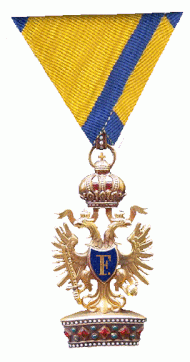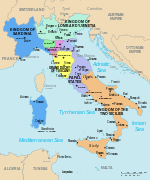Order of the Iron Crown (Austria)
This article includes a list of general references, but it remains largely unverified because it lacks sufficient corresponding inline citations. (March 2017) |
| Imperial Order of the Iron Crown | |
|---|---|
 Medal of the Order | |
| Awarded by the Emperor of Austria | |
| Type | Dynastic order |
| Royal house | House of Habsburg |
| Awarded for | Civil and Military Merit |
| Status | Dormant since 1918 |
| Grades | Knight Grand Cordon with Collar, Special Class Knight Grand Cordon with Collar Knight/Dame Grand Cordon Knight/Dame Commander Knight/Dame |
| Precedence | |
| Next (higher) | Order of Leopold |
| Next (lower) | Order of Franz Joseph |
| Equivalent | Order of Elizabeth |
| Related | Order of the Iron Crown |
Ribbon of the Order | |
The Austrian Imperial Order of the Iron Crown (German: Kaiserlicher Orden der Eisernen Krone; Italian: Ordine imperiale della Corona ferrea) was one of the highest orders of merit of Austria and Austria-Hungary until 1918. It was re-established in 1815 by Emperor Franz I of Austria. The original Order of the Iron Crown had previously been an order of the Napoleonic Kingdom of Italy.
The order had three classes and till 1884 all classes conferred automatic hereditary ennoblement; the third class conferred the rank of Ritter, the second class conferred the rank of Baron and the first class conferred the title of Privy Councillor, the style of Excellency, and the right to attend court. Appointment to the third or second class of the Order of the Iron Crown became one of the main routes to ennoblement for Austrian bourgeois families and for civil servants and military officers. The first class was in practice often awarded to people who were already noble. The order was also awarded to foreigners.
History[]
The Holy Roman Empire, ruled by the Habsburg dynasty, gave way to the Empire of Austria between 1804 and 1806. The last Holy Roman Emperor, Franz II, was proclaimed Emperor Franz I of Austria. His daughter, the Archduchess Maria Louise, was Napoleon’s second wife and Empress Consort, and the mother of Napoleon’s only legitimate son and heir, Napoleon, Duke of Reichstadt. With the collapse of Napoleon’s empire, Imperial Austria regained its traditional control of Lombardy as the Kingdom of Lombardy–Venetia.
The Austrian order was also divided into three distinct classes of knighthood, recognized as the First, Second, and Third Classes. Investment of this order carried an Imperial patent of nobility. With the collapse of the Austro-Hungarian Empire, in 1918, all but one (the Order of the Golden Fleece) of the chivalric orders of its monarchy were formally abolished.
Insignia[]
While the ribbon colors changed from the Imperial French gold and green to the Imperial Austrian gold and royal blue, the general look of the medal remained largely the same – an imperial eagle set within a representation of the Iron Crown of Lombardy. Grand Cross (French) and First Class (Austrian) knights wore a sash and badge over the right shoulder, with an eight-pointed star (that featured the Iron Crown at its center) on the left breast. Imperial French knight commanders wore a traditional military style medal on the left chest, with the addition of a bow in the center of the ribbon to delineate them from ordinary knights. Imperial Austrian Second Class knights wore the medal suspended from a ribbon about the neck. French ordinary knights and Austrian Third Class knights wore a traditional military medal on the left chest.
From 1908 for First Class knights, and from 1917 for Second Class knights, the Imperial Austrian order allowed for an undress version to be worn with service dress. First Class knights were authorized to wear a Third Class military medal on the left breast, with an addition of a device known as a "Kleine Dekoration". The pin device was a miniature version of the First Class breast star, and was worn on the center of the ribbon to delineate the wearer as a knight of the First Class. Variations in the star matched the details of the knight's specific award: including the war decoration wreath and the crossed swords. The Second Class Kleine Dekoration was a miniature depiction of the Iron Crown of Lombardy (copied from the lower part of the actual medal). As with the First Class knights, the Kleine Dekoration for the Second Class knights matched the award to the knights: crown only for peacetime award, crown encircled by a wreath for the war decoration, and topped with swords for those awards "with swords", and was worn in the same fashion as that of the First Class knights.
During World War I, awards "with swords" were given to symbolize personal valour of the knight that led to his award. Hence, ordinary knights medals were also frequently adorned with crossed swords, pinned to the tri-fold ribbon.
 | ||
| Ribbon bars | ||
Notable recipients[]
Masters of the Order[]
- Franz I, Emperor of Austria, 1816–1838
- Ferdinand I, Emperor of Austria, 1838–1848
- Franz Josef I, Emperor of Austria-Hungary, 1848–1916
- Karl I, Emperor of Austria-Hungary, 1916–1918
Knights[]
- James Hamilton, 2nd Duke of Abercorn
- Giuseppe Acerbi
- Alois Lexa von Aehrenthal
- Hasan bey Agalarov
- Archduke Albrecht Franz, Duke of Teschen
- Alfred, 2nd Prince of Montenuovo
- Augusto Carlos Teixeira de Aragão
- Count Kasimir Felix Badeni
- Ferdinand von Bauer
- Heinrich von Bellegarde
- Johannes Benk
- Leon Biliński
- Josef Bílý
- Friedrich Wilhelm von Bismarck
- Herbert von Bismarck
- Otto von Bismarck
- Wilhelm von Bismarck
- Fedor von Bock
- Eduard von Böhm-Ermolli
- Walther Bronsart von Schellendorff
- Adolf von Brudermann
- Rudolf von Brudermann
- Bernhard von Bülow
- Karl von Bülow
- Artur Maximilian von Bylandt-Rheidt
- Leo von Caprivi
- Eduard Clam-Gallas
- Count Manfred von Clary-Aldringen
- Prince Siegfried von Clary-Aldringen
- Cevat Çobanlı
- Franz Conrad von Hötzendorf
- Anton Csorich
- Karl von Czyhlarz
- Maximilian Daublebsky von Sterneck
- Rudolf von Delbrück
- Georg Dragičević
- Ludwig Draxler
- Carl August Ehrensvärd (1858–1944)
- [1]
- Géza Fejérváry
- Ferdinand III, Grand Duke of Tuscany
- Emanuel Salomon Friedberg-Mírohorský
- Ventura García-Sancho, Marquess of Aguilar de Campoo
- Agenor Maria Gołuchowski
- Heinrich von Gossler
- Karl von Habsburg
- Otto von Habsburg
- Wilhelm von Hahnke
- Anton Haus
- Alajos Hauszmann
- Karl Eberhard Herwarth von Bittenfeld
- Miklós Horthy
- Archduke Hubert Salvator of Austria
- Dietrich von Hülsen-Haeseler
- Karl Georg Huyn
- Itō Hirobumi
- Ányos Jedlik
- Archduke Joseph August of Austria
- Archduke Joseph Ferdinand of Austria
- Georg von Kameke
- Gustav von Kessel
- Karl Graf von Kirchbach auf Lauterbach
- Eduard von Knorr
- Hans von Koester
- Alexander von Koller
- Prince Konrad of Bavaria
- Hermann Kövess von Kövessháza
- Franz Kuhn von Kuhnenfeld
- Auguste, Baron Lambermont
- Franciszek Latinik
- Ernst Lauda
- Archduke Leopold Salvator of Austria
- Joseph Maximilian von Maillinger
- Ferdinand von Malaisé
- Edwin Freiherr von Manteuffel
- Jan Matejko
- Gabriel Jean Joseph Molitor
- Helmuth von Moltke the Younger
- Rudolf Montecuccoli
- Georg Alexander von Müller
- Miroslav Navratil
- Nicholas I of Montenegro
- Maximilian Njegovan
- Laval Nugent von Westmeath
- Alexander August Wilhelm von Pape
- Thorleif Paus
- Archduke Peter Ferdinand of Austria
- Karl von Pflanzer-Baltin
- Hans von Plessen
- Ferdinand von Quast
- Joseph Radetzky von Radetz
- Antoni Wilhelm Radziwiłł
- Wilhelm von Ramming
- Manfred von Richthofen
- Sándor Farkas de Boldogfa
- Prince William of Schaumburg-Lippe
- Alfred von Schlieffen
- Emil von Schlitz
- Eberhard Graf von Schmettow
- August Schwendenwein von Lanauberg
- Hans von Seeckt
- Gustav von Senden-Bibran
- Stanisław Smolka
- Hermann von Spaun
- Philipp von Stadion und Thannhausen
- Rudolf Stöger-Steiner von Steinstätten
- Stanisław Szeptycki
- Sándor Szurmay
- Ludwig Freiherr von und zu der Tann-Rathsamhausen
- Myron Tarnavsky
- Karl Tersztyánszky von Nádas
- Tewfik Pasha
- Georg von Trapp
- Fyodor Trepov (senior)
- Aymard d'Ursel
- Illarion Vorontsov-Dashkov
- Ludwig von Welden
- Karl Weyprecht
- Duke William of Württemberg
- Constantin von Wurzbach
- Yamagata Aritomo
- Arthur Zimmermann
- August zu Eulenburg
Sources[]
- Blom, Philipp. To Have and to Hold: An Intimate History of Collectors and Collecting. Overlook, 2003. pp. 146–147.
- Gottschalck, Friedrich. Almanach der Ritter-Orden. Leipzig, Kingdom of Saxony: Georg Joachim Goeschen, 1819.
- Austrian Biographical Encyclopaedia and Biographical Documentation
See also[]
- Nobility
- Order of chivalry
- Order of Franz Joseph
- Order of Leopold
- Order of St. George (Habsburg-Lorraine)
- Orders, decorations, and medals of Austria-Hungary
References[]
- ^ "Encyklopedie dějin města Brna". 2004.
| Wikimedia Commons has media related to Austrian order of the Iron Crown. |
- Orders of chivalry of Austria
- Orders, decorations, and medals of Austria-Hungary
- 1815 establishments in the Austrian Empire
- Military awards and decorations of Austria-Hungary
- Orders, decorations, and medals of the Austrian Empire

